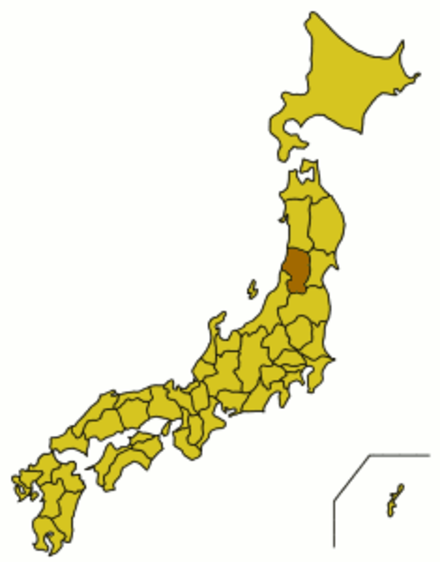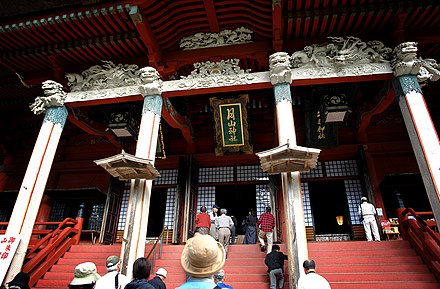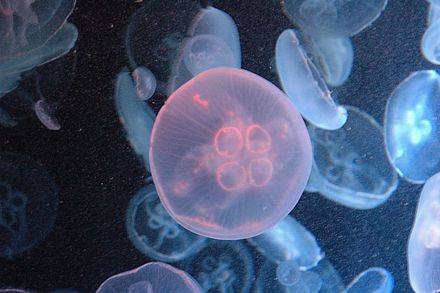Yamagata (prefecture) - prefecture of Japan

Yamagata Prefecture (山形県 Yamagata-ken) is in the northeastern Tohoku region of the main Japan island Honshu.
Understand
Yamagata prefecture is often described as 'hidden' Japan. Well off any tourist route, Yamagata nevertheless has a wealth of experiences for those with the will to seek them out. Home to amazing unspoilt scenery, ancient temples, world class skiing, wonderful local food, summer festivals and some of the best onsen (hot springs) in Japan, Yamagata is a real change for the visitor who believes that Japan is best understood in the municipal centres of Tokyo, Osaka or Kyoto.
Climate
Cities
- Yamagata — prefectural capital famous for Yamadera, onsen, "snow monsters"
- Obanazawa — hot springs and tremendous snowfall. Ginzan Onsen is one of the most famous tourist destinations in the prefecture.
- Sakata — Port town known for its maiko dancers and historic storehouse district
- Shinjo — birthplace of famous manga artists and a famous summer festival
- Tsuruoka — houses 2 of the three Dewa Sanzan temples and a world-famous jellyfish aquarium
- Kaminoyama — famous for hot springs, a former castle town
- Yonezawa — once the home of the mighty Uesugi clan, now better known for Yonezawa beef and hot springs
- Tendo — a small town dedicated to shogi, or Japanese chess
- Higashine
Other destinations

- Yamadera - Buddhist temple carved into solid rock
- Mogami
- Okura
- Oguni
- Nanyo
- Tozawa
- Nishikawa
- Yuza
- Onogawa Onsen
Talk
While standard Japanese is used in Yamagata Prefecture, this place is known for unique local dialects (方言), which even differ from town to town. When speaking with elderly, visitors may encounter difficulty due to their heavy dialects.
Get in
By plane
In Yamagata prefecture, there are airports in Yamagata (IATA: GAJ) (connecting to Osaka-Itami, Nagoya, Tokyo-Haneda, and Sapporo-Chitose) and Shonai Airport (IATA: SYO) (connecting to Tokyo-Haneda). Most visitors coming from overseas will prefer flying to Tokyo and taking the shinkansen from there.
By train
Yamagata prefecture is served by the Yamagata Shinkansen, which zips up every hour from Tokyo through Yonezawa (2 hr, ¥10,000) and Yamagata (3 hr) to Shinjo (3½ hr, ¥12,000). Just don't expect blazing speed: the last 150 km from Fukushima is on ordinary track at 160 km/h, half the speed of a "real" Shinkansen.
By bus
The southern parts of Yamagata prefecture can easily be accessed by express bus from Sendai just to the south.
An one-way trip from Yamagata city to Sendai city costs ¥900 and takes just under an hour. There are also buses connecting Sendai with Shinjo, Kaminoyama, Yonezawa and Sakata city.
Yamagata City is also accessible from Niigata City by bus. A round trip costs ¥6,400, and each way takes about 3 hours. There are two trips a day, one leaving at 08:00 and another one leaving at 16:00. Reservation is required for riding this bus.
There are also night buses connecting Yamagata and Tokyo (various operators), Osaka, and Kyoto.
Get around
By train
Within the prefecture, the Yamagata Shinkansen Tsubasa (山形新幹線つばさ) runs through Yonezawa city to Shinjo city (with stops in Takahata, Akayu, Kaminoyama Onsen, Yamagata, Tendo, Sakuranbo-Higashine, Murayama, Oishida).
Yamagata is also served by the local JR lines and is connected to its neighboring prefectures such as Miyagi, Fukushima and Akita.
By bus
There are high-speed buses available from Yamagata city to Tsuruoka city in the northwest regions of the prefecture.
There is also airport bus that connects the Yamagata airport and Yamagata city (the bus stops are located at Yamagata station and Yamko Building). This bus makes 6 round-trips a day.
There is an extensive bus system serving the area around Yamagata city, connecting major landmarks such as the city hall, the prefectural office, hospitals and schools.
By car
Considered the easiest way to get around the prefecture.
See
 Yamagata is a prefecture of abundant nature.
Yamagata is a prefecture of abundant nature.
- Yamadera - founded in over 1,000 years ago, different buildings of the temple is scattered in the mountain. It is an easy hike to the top, taking about 30 minutes. The view from the mountain top is breathtaking. Different seasons also bring interesting changes to the scenery. (Yamagata)
- Dewa Sanzan - comprised of the three holy mountains, Mt. Haguro, Mt. Yudono and Mt. Gassan, Dewa Sanzan is a place where pilgrims have their spiritual trainings. Here, you can also enjoy "Shojin Ryori" (Buddhist cuisine). At the base of Mt. Haguro, there is the Five-story Pagoda, built in the year of 939, without any nails. (Tsuruoka, Shonai)
- Explore the historic district, including Tohoku's only geisha chaya (Sakata)
- Visit the aquarium with the most jellyfish in the world, the Kamo Aquarium (Tsuruoka)
- See what life was like hundred of years ago at Nishinumata Park (Tendo)
- Snow monsters - in winter on Mt. Zao, visitors can find trees covered by snow forming strange shapes and looking like "snow monsters." (Yamagata)
- Sunset at the Sea of Japan Facing the west side, you can catch beautiful sunsets on the coast of the Sea of Japan. Yunohama Onsen (湯野浜温泉)is a sight especially known for its view of the sunset. (Tsuruoka)
- Mt. Chokai (鳥海山) a famous mountain located at the border of Yamagata Prefecture and Akita Prefecture. (Yuza)
- Sokushinbutsu Yamagata Prefecture has more Buddhist mummies than any other prefecture. There are 4 in Tsuruoka, 2 in Sakata, 1 in Yonezawa, and 1 in Shirataka
Do

- Dewa Sanzan. the Three Mountains of Dewa, holy to the mountain ascetic cult of Shugendo
Hanagasa (Flower Hat) Festival (花笠まつり) - held on August 5-7 every year, a total of 800,000 people come to see this parade from all over Japan. The participants dance for 1.2 km wearing flower hats and traditional wears. About 100 groups participate in the parade, and it is one of the biggest summer festivals in Tohoku region of Japan.
Imoni festival (芋煮会) - held on the first Sunday of September every year in Yamagata city, local residents and tourists gather on the banks of Mamigasaki River to enjoy imoni (taro & beef stew) cooked in a giant pot.
Yonezawa Uesugi Samurai Festival (米沢上杉まつり)l - a spring festival held on April 29 - May 3 every year in Yonezawa city of Yamagata prefecture. The samurai parade held on the last day of the festival is reenactment of the famous historical battles of Kawanakajima. The battles were fought between the two major generals: Kenshin Uesugi and Shingen Takeda.
Mogami River Boat Ride - the Mogami River is a river in Yamagata Prefecture. It flows from the southern part of the prefecture, and turns into the Sea of Japan. A famous poet Matsuo Basho once traveled along the river and made a famous haiku there. Visitors can enjoy a guided boat tour operated by a company called Mogami River Basho Line Descent. It is an one-way descent, taking about one hour for the cost of approximately ¥2,000. From April to November, there are 5 trips a day, and from December to March, there are 3 trips a day.
Montedio Yamagata games - a professional association football (soccer) club based In Yamagata. You can watch their games in ND Soft Stadium in Tendo-city.
Cherry-picking - there are many cherry farms around the prefecture. The best season for cherry-picking is in early summer from June to July.
Soba-making - Yamagata is famous for its soba (buckwheat noodles), and you can even make your own soba from scratch with the help from professional soba makers.
Skiing There several ski slopes in the prefecture, and visitors can go skiing on a day trip. Mt. Zao is the most famous one located near Yamagata city. Near Yonezawa city, there is the Tengendai ski resort. Jangle Jungle ski resort is located in Higashine city.
Pottery-making -Hirashimizuyaki (平清水焼) is a traditional form of pottery originated in Yamagata city. At Shichiuemongama (七右エ門窯), located near Mt. Chitose in Yamagata city, you can take part in the pottery class and make your own Hirashimizuyaki for ¥2,000 with 2 kg of clay.
Eat
Yamagata is famous for its fruits. Yamagata produces 70% share of Japan's cherry production. The most famous cultivator is called "Satonishiki," known for its red color and sweet taste. La France, a type of European pear, is also famous. Yamagata contributes around 80% Japan's production of La France. Other fruits such as grapes, apples, peaches, melons, persimmons and watermelons are also produced in large quantities.
Imoni is a type of stew made with taro potato, beef, konnyaku, sugar, soy sauce or miso. It is traditionally eaten in the autumn of Tohoku region of Japan. Yamagata hosts the biggest imoni festival in Japan in September.
Soba, buckwheat noodles, is also extremely popular in Yamagata. There are many soba restaurants, each with its own specialties.
Yamagata Prefecture has the highest consumption (in terms of money spent) of ramen in Japan, according to a survey conducted by the Ministry of General Affairs in 2004. Yamagata city ranked the highest, with a record of 13,897 yen spend on ramen per household per year. Beside Yamagata city, other cities in the prefecture including Sakata, Yonezawa, Nanyo (Akayu) also have their own distinctive taste in ramen.
Yonezawa beef is a type of Japanese beef originating from the city of Yonezawa in Yamagata Prefecture. It is one of the three most recognized brands in Japan.
Drink
Due to the rich culture of rice-making and clean water carried by Mogami River, Yamagata is known for its delicious Japanaese sake, nihonshu. You can find many brands of locally produced sake in the stores and restaurants.